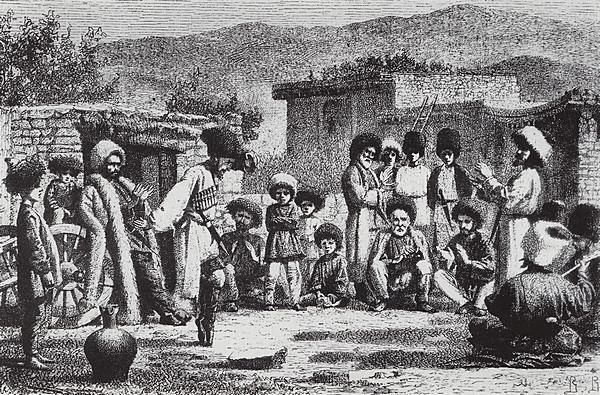 | ||
The Lezginka, also known as the Lezgi dance or Lezgian dance (Lezgian: лезги кьуьл), is a national dance of the Lezgins, common among many peoples in the Caucasus region. Azeris, Nogais, Chechens, Ossetians, Circassians, Karachays, Balkars, Abkhazians, Kabardins, Ingush, Ingilos, Mountain Jews, Georgians, Armenians, Kuban Cossacks, Terek Cossacks, Caucasian Avars, Dargwa, and Kumyks have their own versions.
Contents
The Lezgian dance is a solo male and pair dance. The dance is usually performed in national costumes and accompanied by musical ensemble. The music has a 6/8 rhythm; the melody is clear and dynamic and the pace is fast.
The dance uses a two image. The man moves in the form of an eagle, alternating between a slow and rapid pace. The most spectacular movements are those of the man when he is on his toes, throwing his hands in different directions. The woman moves in the form of a swan, using graceful posture and smooth hand movements. She increases the tempo of her dance after the man. The dance, common among all the Caucasian peoples, was named in accordance with the ancient totem of the Lezgins: the word "Lek" (Lezgian: лекь) means eagle.
According to Encyclopædia Britannica:
Lezginka, also spelled Lezghinka, folk dance originating among the Lezgian people of the Caucasus. It is a male solo dance (often with a sword) and also a couple dance. The man, imitating the eagle, falls to his knees, leaps up, and dances with concise steps and strong, sharp arm and body movements. When the dance is performed in pairs, couples do not touch; the woman dances quietly as she regards the man’s display.
Types of dance
There are two types of Lezgian dance as a whole, the types might variate from one people to an other. Some types of dances originates from one nationality while a different one might originate from an other, but yet both dance it (This is a frequent thing with Caucasian dances).
The "Lezgian dance" fast dance is the only dance common to all people of the Caucasus, but each nationality dances it differently.
The two types are: Mountain dance or Highlander dance and Lyrical dance
Mountain dance originates from people of the Caucasus originally from mountain parts, every nationality has their own little variation. There are a very few variations of this type of dance. It is probably the hardest and one of the most beautiful dances of all. It is a dance where you change positions, literally, in less than one second, one often breaks down to sit on the knees and the jumps back up to a different position and then changes again.
In North Caucasus this is a pure mans dance. But in Georgia women have a version of this dance which is not at all alike what the men do, but they dance in pairs.
